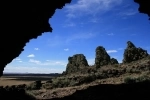Pali Aike National Park. Punta Arenas - CHILE
This National Park covers an area of approximately 5030 hectares of scenic beauty and unique geological features in the country which gives it a great tourist attraction and cultural heritage.
It is located in the most arid section of the Magellanic steppe. Most of the surface is covered by vast effusions of basaltic lava, which determines the existence of semi-desert vegetation. The existence of many low-lying volcanic cones, natural caves, abundant craters, cliffs and basaltic lava fields resemble a moonscape. Created in 1970, Pali Aike National Park is unique in the country for its geological features, exotic lunar landscapes and the unique mix of gray tones in the ruins that recall the volcanic lava of the mountainous area of Region XII.
In this, virtually unknown National Park, located 52 degrees south latitude and 69 º 30 west longitude, in the Commune of San Gregorio, on the border with Argentina to 210 kms northeast of the City of Punta Arenas. In 1994 his initial surface of 2,020 hectares was almost doubled by resolution of the Ministries of National Heritage and Agriculture and is now with 5030 acres, in consideration of their geological importance, historic, archaeological and fauna, besides serving the purpose of preserving the Patagonian steppe .
St. Gregory was the first to sight Chilean territory Ferdinand Magellan in 1520 and archaeologists have found evidence for the presence of indigenous or tehuelches aonikenk who named it "Devil s Land" for its odd setting and changing geography. However, they were the first to occupy these sites and attractions in the Fell and Pali Aike caves were the earliest human remains in this part of the continent, dating back some 11 thousand years.
It can be seen quite scarce species of mammals in other parts of the region armadillos, wild cats, huroncitos Patagonian skunks (Conepatus humboldti), gray foxes or shingles (Canis griseus) and eared bat (Histiotitis montanus chiloensis), yellow-nosed mouse ( Akodon olivaceus) Mouse Conero (Reithrodon physodes auritus) and introduced species such as the hare (Lepus europaeus). The largest populations are from guanaco (Lama guanicoe) characteristic of the steppe animal, is found in a number close to 400 books in the area and Ostriches (Pterocnemia pennata). Among the birds are frequently seen queltehues or uterus (Venellus chilensis), caiquenes (Chloephaga picata), vultures or taro (Caracara), kestrels (Falco parverius) and at certain times flocks of flamingos.
The vegetation is located in territory of the Cold or Patagonian steppe, in its most arid section, due to extensive rainfall and lava spills of up to 200 to 300 mm. Annual.
Plant species characteristics are Festuca gracillima, Festuca pallescens and Stipa all associated humillis coirón forming. Among shrubs can be found El Calafate (Berberis buxifolia), Black Bush (Verbena tridens) and sometimes the myrtle (Empetrum rubrum). The Pali Aike volcanic area, integrated into the historical geography of Patagonia called "Country Tehuelche" for having been the traditional site of the indigenous people known as Tehuelches, or more properly Patagones Aonikenk.
These aborigines inherited the land for thousands of years, finding in these places a traditional hunting territory, for which regularly moved between locations or stops temporary use, individualized language Aonikoaish as Aik or Aiken.
However, the frequency with which roamed the area Aonikenk not fail to feel a superstitious fear for his strange landscape that Pali Aike designated as "The Devil s Country," meaning that he should dwell in evil spirits.
The route runs along the Magellan Strait in areas such as San Gregorio former residence located at 124 kms. Punta Arenas, senior roster farmer in Patagonia, and on whose shores lie the remains of the steam Amadeo (National Historic Landmark), stranded on the shore of the Strait. Currently the park does not have any infrastructure or administrative staff, being in the study implementation.






